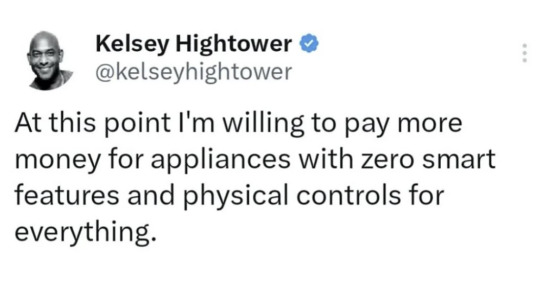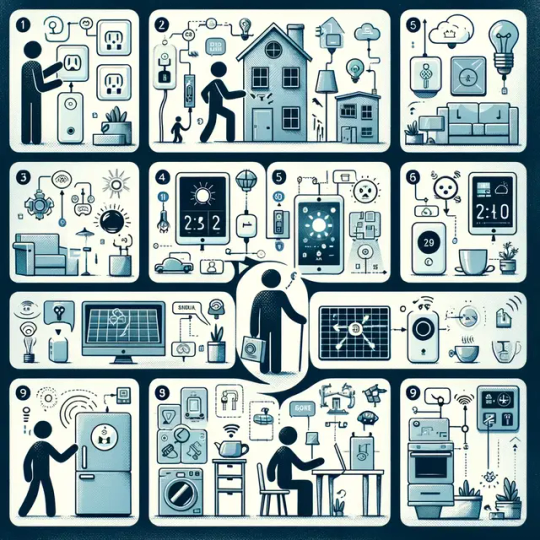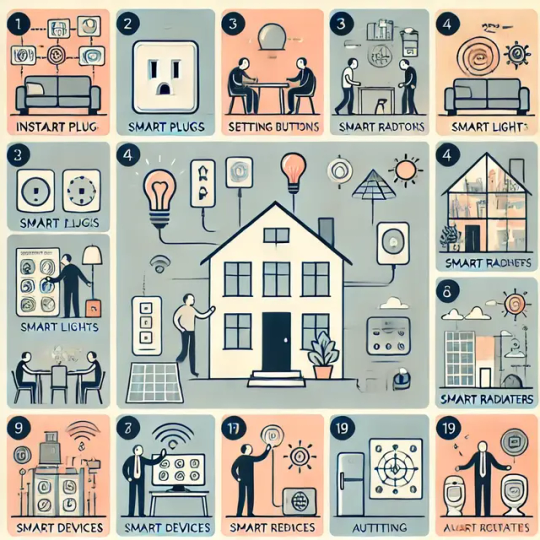#Smart Devices
Explore tagged Tumblr posts
Text

MIT researchers have developed a battery-free, self-powered sensor capable of harvesting energy from its environment. This innovation could pave the way for mobile phones that charge themselves while in your pocket.
#MIT#Energy Harvesting#Self Powered#Mobile Tech#Innovation#Wearable#Battery Free#Smart Devices#Ambient Energy#Technology
163 notes
·
View notes
Text
We ask your questions anonymously so you don’t have to! Submissions are open on the 1st and 15th of the month.
#polls#incognito polls#anonymous#tumblr polls#tumblr users#questions#polls about the internet#submitted feb 15#smart devices#virtual assistants#google
144 notes
·
View notes
Text

#memes#meme#lol#funny#lol memes#funny memes#funny meme haha#funny stuff#millenials#smartfridge#refrigerator#smart devices#ai#too much#skynet#hal 9000#i just want a normal fridge
80 notes
·
View notes
Text
"In the age of smart fridges, connected egg crates, and casino fish tanks doubling as entry points for hackers, it shouldn’t come as a surprise that sex toys have joined the Internet of Things (IoT) party.
But not all parties are fun, and this one comes with a hefty dose of risk: data breaches, psychological harm, and even physical danger.
Let’s dig into why your Bluetooth-enabled intimacy gadget might be your most vulnerable possession — and not in the way you think.
The lure of remote-controlled intimacy gadgets isn’t hard to understand. Whether you’re in a long-distance relationship or just like the convenience, these devices have taken the market by storm.
According to a 2023 study commissioned by the U.K.’s Department for Science, Innovation, and Technology (DSIT), these toys are some of the most vulnerable consumer IoT products.
And while a vibrating smart egg or a remotely controlled chastity belt might sound futuristic, the risks involved are decidedly dystopian.
Forbes’ Davey Winder flagged the issue four years ago when hackers locked users into a chastity device, demanding a ransom to unlock it.
Fast forward to now, and the warnings are louder than ever. Researchers led by Dr. Mark Cote found multiple vulnerabilities in these devices, primarily those relying on Bluetooth connectivity.
Alarmingly, many of these connections lack encryption, leaving the door wide open for malicious third parties.
If you’re picturing some low-stakes prank involving vibrating gadgets going haywire, think again. The risks are far graver.
According to the DSIT report, hackers could potentially inflict physical harm by overheating a device or locking it indefinitely. Meanwhile, the psychological harm could stem from sensitive data — yes, that kind of data — being exposed or exploited.
A TechCrunch exposé revealed that a security researcher breached a chastity device’s database containing over 10,000 users’ information. That was back in June, and the manufacturer still hasn’t addressed the issue.
In another incident, users of the CellMate connected chastity belt reported hackers demanding $750 in bitcoin to unlock devices. Fortunately, one man who spoke to Vice hadn’t been wearing his when the attack happened. Small mercies, right?
These aren’t isolated events. Standard Innovation Corp., the maker of the We-Vibe toy, settled for $3.75 million in 2017 after it was discovered the device was collecting intimate data without user consent.
A sex toy with a camera was hacked the same year, granting outsiders access to its live feed.
And let’s not forget: IoT toys are multiplying faster than anyone can track, with websites like Internet of Dongs monitoring the surge.
If the thought of a connected chastity belt being hacked makes you uneasy, consider this: sex toys are just a small piece of the IoT puzzle.
There are an estimated 17 billion connected devices worldwide, ranging from light bulbs to fitness trackers — and, oddly, smart egg crates.
Yet, as Microsoft’s 2022 Digital Defense Report points out, IoT security is lagging far behind its software and hardware counterparts.
Hackers are opportunistic. If there’s a way in, they’ll find it. Case in point: a casino lost sensitive customer data after bad actors accessed its network through smart sensors in a fish tank.
If a fish tank isn’t safe, why would we expect a vibrating gadget to be?
Here’s where the frustration kicks in: these vulnerabilities are preventable.
The DSIT report notes that many devices rely on unencrypted Bluetooth connections or insecure APIs for remote control functionality.
Fixing these flaws is well within the reach of manufacturers, yet companies routinely fail to prioritize security.
Even basic transparency around data collection would be a step in the right direction. Users deserve to know what’s being collected, why, and how it’s protected. But history suggests the industry is reluctant to step up.
After all, if companies like Standard Innovation can get away with quietly siphoning off user data, why would smaller players bother to invest in robust security?
So, what’s a smart-toy enthusiast to do? First, ask yourself: do you really need your device to be connected to an app?
If the answer is no, then maybe it’s best to go old school. If remote connectivity is a must, take some precautions.
Keep software updated: Ensure both the device firmware and your phone’s app are running the latest versions. Updates often include critical security patches.
Use secure passwords: Avoid default settings and choose strong, unique passwords for apps controlling your devices.
Limit app permissions: Only grant the app the bare minimum of permissions needed for functionality.
Vet the manufacturer: Research whether the company has a history of addressing security flaws. If they’ve been caught slacking before, it’s a red flag.
The conversation around sex toy hacking isn’t just about awkward headlines — it’s about how we navigate a world increasingly dependent on connected technology. As devices creep further into every corner of our lives, from the bedroom to the kitchen, the stakes for privacy and security continue to rise.
And let’s face it: there’s something uniquely unsettling about hackers turning moments of intimacy into opportunities for exploitation.
If companies won’t take responsibility for protecting users, then consumers need to start asking tough questions — and maybe think twice before connecting their pleasure devices to the internet.
As for the manufacturers? The message is simple: step up or step aside.
No one wants to be the next headline in a tale of hacked chastity belts and hijacked intimacy. And if you think that’s funny, just wait until your light bulb sells your Wi-Fi password.
This is where IoT meets TMI. Stay connected, but stay safe."
https://thartribune.com/government-warns-couples-that-sex-toys-remain-a-tempting-target-for-hackers-with-the-potential-to-be-weaponized/
#iot#I only want non-smart devices#I don't want my toilet to connect to the internet#seriously#smart devices#ai#anti ai#enshittification#smart sex toys
26 notes
·
View notes
Text
Exploring the Benefits of Smart Home Technology with Dreame
The smart home industry is rapidly evolving, and brands like Dreame are at the forefront of this innovative wave. With technology advancing at an incredible pace, smart home devices are becoming more accessible and affordable for everyone.
Dreame offers a range of smart home products that enhance convenience and efficiency in our daily lives. From smart vacuum cleaners that navigate your home with ease to air purifiers that ensure clean air, Dreame's commitment to quality and innovation is evident.
One of the standout features of Dreame products is their ability to connect seamlessly with other smart home devices. This integration allows users to create a fully automated home environment, making everyday tasks simpler and more enjoyable.
Additionally, Dreame is currently offering a fantastic promotion with a 40% discount on select products. This is a perfect opportunity for those looking to upgrade their home with smart technology at an incredible value.
Investing in smart home technology not only enhances your lifestyle but also contributes to energy efficiency and cost savings in the long run. With brands like Dreame leading the charge, the future of smart homes is bright and full of possibilities.
Reference: http://www.dreame.com/smarthome
11 notes
·
View notes
Text
Thank you God for not making me think smart watches are cool.
33 notes
·
View notes
Text

The Future is Bright!
#The Future is Bright!#futuristic#futurism#future#ausgov#politas#australia#earth#humans#artificial intelligence#smart devices#smart home devices#auspol#tasgov#taspol#fuck neoliberals#neoliberal capitalism#anthony albanese#albanese government#extinction#extinct animals#extinct species#extinct birds#ai generated#ai art#ai artwork#ai girl#ai#a.i. art#a.i. generated
6 notes
·
View notes
Text
Share the video of AOZORA K8 series' durability: waterproof, dustproof and Anti-vibration.
#travel#nature#electronic devices#mobile devices#adventure#smart devices#tabletop#riding#hiking#motorcycle#bikeriding#smartphone#technology#android#outdoors#explore#camping#hike#game#gym#rowing#walking
3 notes
·
View notes
Text
CardioCheck Duo - Smart Blood Pressure Monitor With ECG
MediGo Flex is committed to putting reliable, medical-grade technology into the hands of individuals, empowering them to take control of their health from the comfort of their homes. We offer a holistic view of key heart health indicators, which is a smart blood pressure monitor with ECG. Our compact device combines blood pressure monitoring and ECG analysis for a complete view of heart health, which supports early detection and management of cardiac conditions. Buy now!

2 notes
·
View notes
Text
There are some adults that say that you won’t even notice you’re addicting to your device.
We can assure you that every single one of us on the internet understands we’re on here way too much. Hasn’t stopped us yet.
2 notes
·
View notes
Text
Maybe it’s just me. But new gadgets/tech sucks.
I’m going to need a new phone because I know my current phone can’t keep up with my lifestyle for much longer. It can’t hold a charge all day, it overheats easily, etc. going to need a new phone. And the mainstream choices are the Samsung S series, Google Pixel, or Apple iPhone. They all look the fucking same. They all brag about features I’m probably not going to use. And they all have “ecosystems” that encourage brand loyalty and brand exclusivity. And I hate it.
I’ve been an android user as long as smart phones have existed, primarily Samsung products. But I have a MacBook Air and iPad so my phone isn’t compatible with my other tech anyways. My heart is telling me to be a non-conformist and buy a Motorola Razr (also, because my inner eleven year old is still sad I never had the original Razr). But then I’ll lack support and accessories because only the big 3 are typically catered to.
It’s just so frustrating to me. I’m going to go through the same struggles when my car eventually craps out on me too. But again, everything looks the same, has the same brags. I hate it. Where is the customization options? The uniqueness? Artistry in design?
3 notes
·
View notes
Text
Wire Gadgets

Welcome to Wire Gadgets, your ultimate destination for the latest and most innovative high-tech gadgets on the market. Whether you're a tech enthusiast or simply looking to upgrade your lifestyle with the most cutting-edge devices, we've got you covered. From sleek electronics to smart home solutions, wearables, and futuristic accessories, Wire Gadgets brings you the best in modern technology. Our carefully curated selection features products that blend style, functionality, and performance, ensuring that you stay ahead of the curve. Dive into the world of tomorrow’s tech today with Wire Gadgets – where innovation meets convenience.
#High-tech gadgets#smart devices#innovative technology#cutting-edge electronics#futuristic accessories#tech products#modern gadgets#wearable tech#smart home solutions#tech innovations#sleek electronics#gadget reviews#technology trends#advanced gadgets#smart lifestyle#tech enthusiasts#future technology#top gadgets#electronic accessories#high-tech devices.
2 notes
·
View notes
Text


This is what DALL·E thinks about smart home 💡
#dalle#ai fails#funny#fails#fail#artificial intelligence#nonsense#failure#funny fails#funny stuff#funny post#humor#jokes#lol#haha#ai#ai generated#ai art#misunderstandings#misunderstood#smart home devices#home automation#smart home system#smart home automation#automation#smart devices#smart design
4 notes
·
View notes
